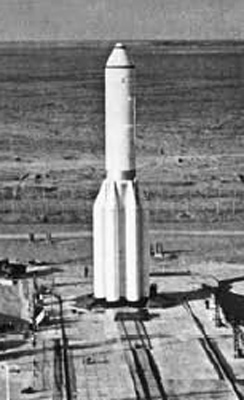
UR-500
In-activeKhrunichev State Research and Production Space Center (KhSC)
July 16, 1965
Description
Proton is an expendable launch system used for both commercial and Russian government space launches. The first Proton rocket was launched in 1965.
Specifications
-
Stages
2 -
Length
46.28 m -
Diameter
4.15 m -
Fairing Diameter
4.15 m -
Launch Mass
595.0 T -
Thrust
8847.0 kN
Family
-
Name
UR-500 -
Family
― -
Variant
― -
Alias
― -
Full Name
UR-500
Payload Capacity
-
Launch Cost
― -
Low Earth Orbit
8400.0 kg -
Geostationary Transfer
Orbit
― -
Direct Geostationary
― -
Sun-Synchronous Capacity
―
Khrunichev State Research and Production Space Center
Government
Director: Andrey Vladimirovich Kalinovskiy
KhSC 1916Khrunichev State Research and Production Space Center is a Moscow-based producer of spacecraft and space-launch systems, including the Proton and Rokot rockets and is currently developing the Angara rocket family. The Proton launch vehicle launches from Baikonur and Rokot launches from Baikonur and Plesetsk. Angara will launch from Plesetsk and Vostochny.
UR-500 | Proton 3
Khrunichev State Research and Production Space Center | RussiaBaikonur Cosmodrome, Republic of Kazakhstan
July 6, 1966, 12:57 p.m.
UR-500 | Proton 3a
Khrunichev State Research and Production Space Center | RussiaBaikonur Cosmodrome, Republic of Kazakhstan
March 24, 1966, 2:39 p.m.
UR-500 | Proton 2
Khrunichev State Research and Production Space Center | RussiaBaikonur Cosmodrome, Republic of Kazakhstan
Nov. 2, 1965, 12:28 p.m.
UR-500 | Proton 1
Khrunichev State Research and Production Space Center | RussiaBaikonur Cosmodrome, Republic of Kazakhstan
July 16, 1965, 11:16 a.m.
Falcon 9
CSG-3
Space Launch Complex 4E - Vandenberg SFB, CA, USACSG-3 is an Earth observation satellite for the Italian Space Agency, part of a reconnaissance constellation using synthetic aperture radars operatin…
Long March 7A
Shijian 29 A-B
201 - Wenchang Space Launch Site, People's Republic of China2 satellites officially described as for "demonstration of new technologies for spatial targets detection" purposes.
Long March 4B
Tianhui 7
Launch Area 94 (SLS-2 / 603) - Jiuquan Satellite Launch Center, People's Republic of ChinaA satellite officially described as for cartography purposes, details TBD.
Soyuz 2.1b/Fregat-M
AIST-2T 01 & 02
Cosmodrome Site 1S - Vostochny Cosmodrome, Siberia, Russian FederationA pair of Russian optical Earth observation satellites built by the Progress Rocket Space Centre for obtaining stereo images of the Earth's surface, …
Long March 3B/E
Fengyun-4C
Launch Complex 2 (LC-2) - Xichang Satellite Launch Center, People's Republic of ChinaChina's geostationary meteorological satellite program FY-4 (Feng Yun 4) is the second generation of chinese geostationary meteorological satellites.

